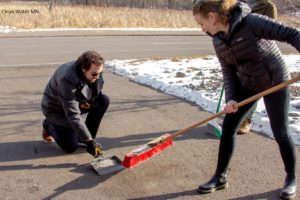What’s the Deal with Chloride?
Winter is approaching and with it comes snow, ice, and cold weather. While we can’t get away from using deicers like salt, we can be educated about best practices to reduce our environmental impact as well as save money. More salt does not mean more melting or more safety, so it’s best to use only what is needed. Any excess salt will eventually end up in our waterways and once there, it is too costly to remove. You can cover 1,000 square feet of surface using only 4 pounds or less of salt: one pound of salt is a heaping coffee mug full. When spreading the salt on the ground, make sure the grains have 2-3 inches of space between them. It is best to shovel during the snowfall, and only use salt after that if needed. Once the salt has done its work, sweep any extra salt to use it again.
Like previously mentioned, once the salt enters our waterways, it is too expensive to remove. A main component of most sidewalk salts is chloride which will not break down or get filtered out once it contaminates the water. High chloride levels are toxic to fish and plants and damaging to infrastructure. Just 1 teaspoon of salt will permanently pollute 5 gallons of water.

What can you do help reduce over salting while still staying safe? Shovel during and after the snowfall to prevent the buildup of snow and ice. When salting, only use what you need and sweep up any excess to use again. Salt takes time to work, give it time before you spread more. Lastly take a Smart Salting class and encourage your contractor to take it too! Learn more about smart salting practices and become a certified Smart Salter. The next training is on November 15, which you can register for here: ninemilecreek.org/whats-happening/upcoming-events/smart-salting-parking-lot-sidewalk/
Visit the MPCA website to learn more: pca.state.mn.us/business-with-us/smart-salting-training
